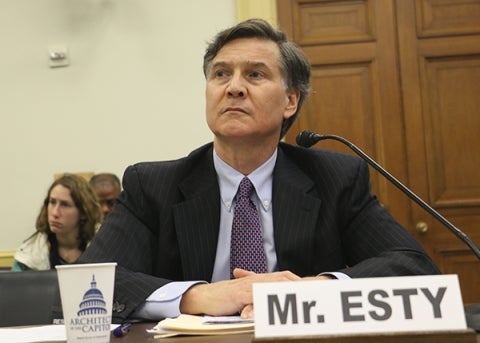Note: Yale School of the Environment (YSE) was formerly known as the Yale School of Forestry & Environmental Studies (F&ES). News articles and events posted prior to July 1, 2020 refer to the School's name at that time.
 Daniel Esty
Daniel Esty
The red lights approach made sense five decades ago as the need to stop harm-causing behavior seemed obvious. From Cleveland’s Cuyahoga River catching fire to the thick smog that often hung over Los Angeles to the toxic waste and human health crisis of Love Canal, the problems seemed obvious. The public demanded action. With a primate base of environmental knowledge and limited theory about how to respond to pollution threats, government-defined regulatory mandates offered a path forward. And they worked — to some extent. Our air and water are much cleaner today. Chemicals are regulated, and waste disposal occurs under a regime of careful controls.
While regulatory rules and prohibitions have a place in controlling pollution, our present environmental law and policy framework must be seen as incomplete.
But this progress has come at a price. The command and control framework is now widely recognized as slow and inefficient insofar as the government does almost all of the environmental work — spotting problems, analyzing the causes of various harms, identifying safe pollution thresholds, spelling out standards, and sometimes even requiring specific “best available technologies” to be adopted by particular industries. This over-reliance on government as the central (and often sole) actor also leads to high costs, avoiding inefficiencies, constant litigation over standards, and disincentives for innovation.
Today, we know, moreover, that red lights are not enough. Limiting or even forbidding pollution is not the same as solving environmental problems. Just as a traffic intersection needs green lights as well as red ones to optimize the flow of vehicles, we need a policy framework that highlights for businesses and individuals across the nation and around the world where problems exist that require solutions — and thus where their innovative thinking would be particularly welcome. Fundamentally, while the red lights framework of the past helped us curb pollution, reduce waste, and limit chemical exposures, it did not spur transformative change in response to critical challenges such as the need for breakthroughs in clean energy or expanded funding for safe drinking water. It did not engage the business community and the financial markets as potential problem solvers.
So while regulatory rules and prohibitions have a place in controlling pollution, our present environmental law and policy framework must be seen as incomplete… More could be — and should be — done to promote innovation as a centerpiece of America’s energy and environmental strategies. The push for fresh thinking and new ideas should, of course, include technology development, but it should also promote innovation in policy approaches, public engagement, conservation, and finance for environmental infrastructure (including expanded funding for renewable power, electricity storage, drinking water systems, sewage treatment, clean technologies for industry, and low-emissions mobility). Law and policy should ensure that the work of environmental protection is not seen as solely the purview of the public sector. Rather, incentives should be in place to encourage broad engagement in environmental problem-solving that draws companies, inventors and creative spirits of all kinds, think tanks, research centers, universities, and other nongovernmental entities into the pursuit of a sustainable future.
Incentives to innovate
The expanded framework of green lights that I envision would take many forms. Perhaps the greatest spur to innovation and a transformed future would be a commitment to adopt the polluter pays principle and to insist on an ‘end to externalities’— meaning that those who inflict environmental harms on society must pay for them. Implementation of this principle would require that those who cause air or water pollution or chemical exposures and spill harms beyond their own property lines — or who consume natural resources without paying for their full value — be charged for their emissions or other negative impacts. These harm charges would establish a very substantial incentive (or green light) that would signal where efforts to remake products or production processes would find a payoff.
 <h5> <a href="/news/article/path-toward-a-decarbonized-economy-will-require-incentives-to-innovation-esty-tells-lawmakers/">Incentives for Innovation Can Drive Decarbonization, Esty Tells Lawmakers</a></h5><p> While the top-down regulatory policies of the 20th century achieved critical advances in environmental protection, the challenges of the 21st century demand new strategies, Daniel Esty recently told U.S. lawmakers. <a href="/news/article/path-toward-a-decarbonized-economy-will-require-incentives-to-innovation-esty-tells-lawmakers/">Read more</a></p>
<h5> <a href="/news/article/path-toward-a-decarbonized-economy-will-require-incentives-to-innovation-esty-tells-lawmakers/">Incentives for Innovation Can Drive Decarbonization, Esty Tells Lawmakers</a></h5><p> While the top-down regulatory policies of the 20th century achieved critical advances in environmental protection, the challenges of the 21st century demand new strategies, Daniel Esty recently told U.S. lawmakers. <a href="/news/article/path-toward-a-decarbonized-economy-will-require-incentives-to-innovation-esty-tells-lawmakers/">Read more</a></p>
Green lights can take other forms and spur innovation in other domains. For example, one of the biggest mistakes in our current environmental protection regime has been the assumption that once pollution control requirements were in place, the money to implement them would follow. And while big industries have spent millions of dollars on smokestack scrubbers and effluent controls, much less investment in pollution control technologies has been made by small businesses, households, and other entitities with limited access to capital. But in recent years, innovative financing tools, such as Green Banks and Green Bonds, have created new incentives that encourage investment in environmental infrastructure. These “sustainable finance” green lights make capital available at attractive rates for borrowers — a model that could easily be expanded.
Continuous improvement
I recognize that my call for much greater attention to incentives for actions and innovation inescapably requires political decisions about what issues get tagged for green lightfocus and prioritization. Given this reality, there will be disputes over the framework of incentives created and the sorts of signals that get sent out. But I hope the broader point about needing to refresh America’s approach to sustainability — and to bring an emphasis on innovation to the energy and environmental arenas — does not get lost.
Change is never easy, especially within a fraught political context. But whether we call it continuous improvement or regular revitalization, the importance of innovation leading to new and better ways of doing essential activities — including our approaches to energy strategy and environmental protection — needs to be highlighted. Indeed, one of the most significant findings in social science of recent decades centers on the importance of innovationto healthy organizations.
Baseball teams pick players today in a very different way than they did in the 1970s. Rather than tobacco-chewing scouts making recommendations based on intuition in their “gut,” teams now rely on data geeks such as Theo Epstein, whose pioneering approach to baseball data analytics has delivered world championships for the long-denied Boston Red Sox and Chicago Cubs. Epstein’s fresh thinking about the underpinnings of success in pitching, hitting and fielding — built on advanced data analytics and new metrics (such as a focus on on-base percentage rather than batting average) — has now been adopted by all the major league teams.
We cannot possibly meet the demands of the emerging ‘sustainability imperative’ with a twentieth-century policy framework that has failed to capitalize on recent breakthroughs.
Likewise, corporate leaders in every industry have come to learn that they must constantly reinvent their business models and corporate strategies to stay competitive and profitable. As a result, companies today market their products and target their customers in very different ways from a generation ago. They rely on new data science, micro-targeting of potential buyers, and constant testing, tracking, and refining of sales pitches to stay ahead of the market.
Other institutions, including government entities, have similarly learned to remake themselves to stay vibrant. Some parts of our administrative state have been fundamentally re-engineered for the twenty-first century. In fact, recast telecommunications regulations helped usher in the smartphone era. Major regulatory reforms have also transformed the airline industry, railroads, and other sectors of society.
But the foundations of energy and environmental policy have remained largely static for decades — and this must not continue. So even if there will be disputes over the structure of green lights and the direction of change, that conversation will be important. We cannot possibly meet the demands of the emerging “sustainability imperative” with a twentieth-century policy framework that has failed to capitalize on recent breakthroughs in mapping pollution flows, tracing ecological and epidemiological effects, and understanding chemical exposure thresholds and so many of the other advances in knowledge that have emerged in the past four decades. It is time to put Big Data, the internet, advanced sensors, omnipresent telecommunications links, and other tools of our Digital Age to work on energy and environmental challenges. A commitment to incentives — green lights — that facilitate innovation needs to be at the heart of a remade sustainability policy framework.